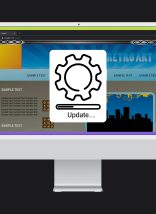The majority of all large-scale web development projects don’t finish on schedule. You may be nodding your head knowingly or gasping in fear. Regardless, many studies and surveys show this unfortunate truth. Budgeting goals also fare poorly. A very high percentage of projects go over budget. These factors make the the already daunting task of completing a complex project, more harrowing. Scheduling and budgeting issues occur for a variety of reasons. Large-scale web development projects tend to become bigger as they’re built. They also become more complex than planned as the design process evolves. New ideas pop up, inspired by the project as it takes shape. However, we can’t lay these issues right at the feet of clients and executives who always want more. Our experiences have taught us otherwise. The biggest impediment to a finished, successful institutional website is poor planning. How does this happen? Everyone knows that planning is essential to a large task. The problem is its implementation. Some web development teams don’t ask enough questions. As a result, they don’t understand the projects they’re working on in a detailed and intensive way. There are too many generalities in play. Even worse, they fail to piece together a tangible path forward. There are no flowcharts, timelines, or milestones established. These crucial elements that lead to productivity and efficiency are nonexistent. What they need is a strong and clear web development plan.
There is one aspect of the planning process that we have found to be incredibly important. You may not have ever considered it. But, it can help you to iron out major wrinkles in the web development process and begin your project with a web development plan you can count on. Sequential vs. Parallel Planning
Many web development clients and inexperienced design and programming teams share one commonality. They think of building a website as a series of actions to do,one at a time. The process of web development becomes one long ‘to-do’ list. This is technically true, in a very strict sense. But it doesn’t maximize time or effort. There are two kinds of tasks that must be identified in order to craft a web development plan that works.
Sequential Planning
Some tasks are sequential. You must complete them in a specific order. One task is dependent on the completion of the previous one, and so on. It’s a basic domino effect. Jumping ahead would make the process more difficult or lead to avoidable mistakes.
You wouldn’t want to begin filling in the content on your website until you’ve chosen fonts and colors. Installing plug-ins or developing custom apps would be useless without a basic layout. You can’t know what you need until it’s clear what you have. Trying to do things out of order would only lead to duplicated work and unnecessary delays. This is a waste of resources and is a direct cause of scheduling conflicts. With sequential tasks, one step at a time keeps the team steady on the path. Parallel Planning
Completing tasks in sequential order seems obvious. That mind set, as we said, can actually be a hindrance when it comes to planning complex projects. That’s because there are many steps in the web development process that can be parallel. These are tasks that are not dependent on the completion of other work before tackling them. They’re integral pieces to the puzzle, but are stand-alone activities. You can outline content in word processing documents while design work is progressing. These two jobs can happen concurrently. Or you can gather images while programmers work on new pieces of software. As one team collects viable search engine phrase targets, another can test software. These kinds of tasks are important to find as you look to optimize your team’s time.
Bringing it All Together
An experienced web development team will know that differentiating tasks is important. They will take the time to set up a comprehensive plan that incorporates every action. Sequential and parallel tasks will work in tandem to create an efficient schedule. The proper order of tasks is clear. Even better, your team will have found all parallel tasks and included them in the plan. Identifying those tasks and planning for them accordingly gives the entire project a strong head start. It might take a few days, or even longer, to organize an ideal strategy. But, that forethought can save entire weeks of time down the road. That will be especially true when dozens of people are working on various parts of the new site at once. The last thing a client or creative team wants is the launch of new website held up. Especially because a few small details are missing or testing isn’t complete. You need a plan for the development of your website, and it has to be more than a simple checklist. Don’t work with any design firm that doesn’t understand the importance of having a detailed schedule and strategy in place. Particularly a strategy that has order and emphasizes the vitality of parallel actions. A good web development plan utilizes all the components of the complex project to give the creative team an advantage.
We Are Your Institutional Web Design Experts
At Atlantic BT, we have decades of experience working with large organizations in every sector. We’ve been building partnerships here in our Raleigh, NC home and beyond. Implementing a web development plan that works for our clients is only the first step in helping them achieve their goals. Whether you’re trying to create a never-before-seen new website or revamp the pages and apps you already have, we can help. Contact our team today to schedule a meeting to discuss your needs. We can work together to craft a strategy that’s right for you and your vision. 





